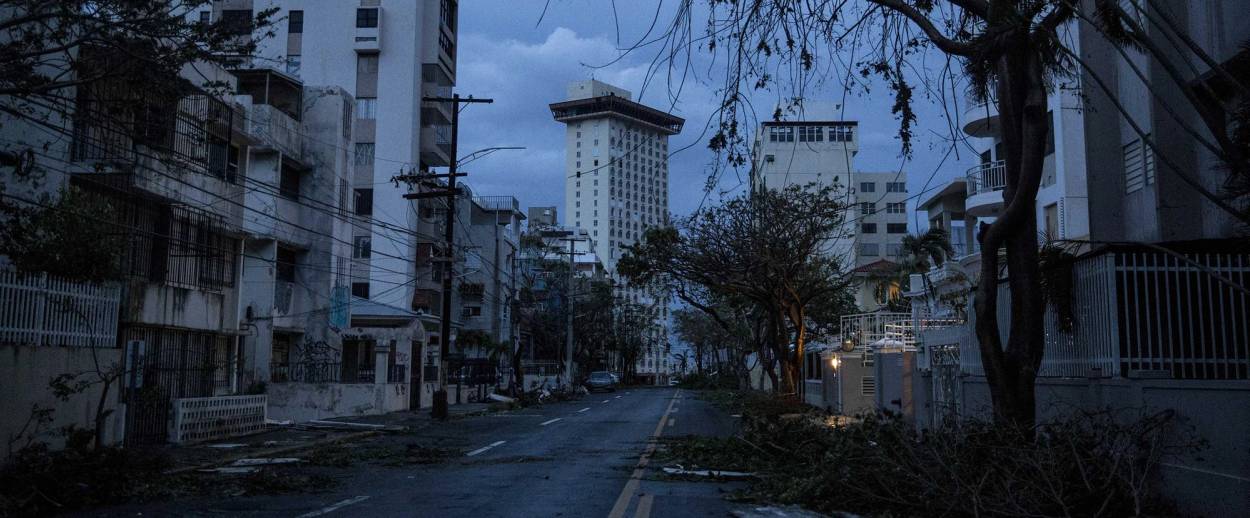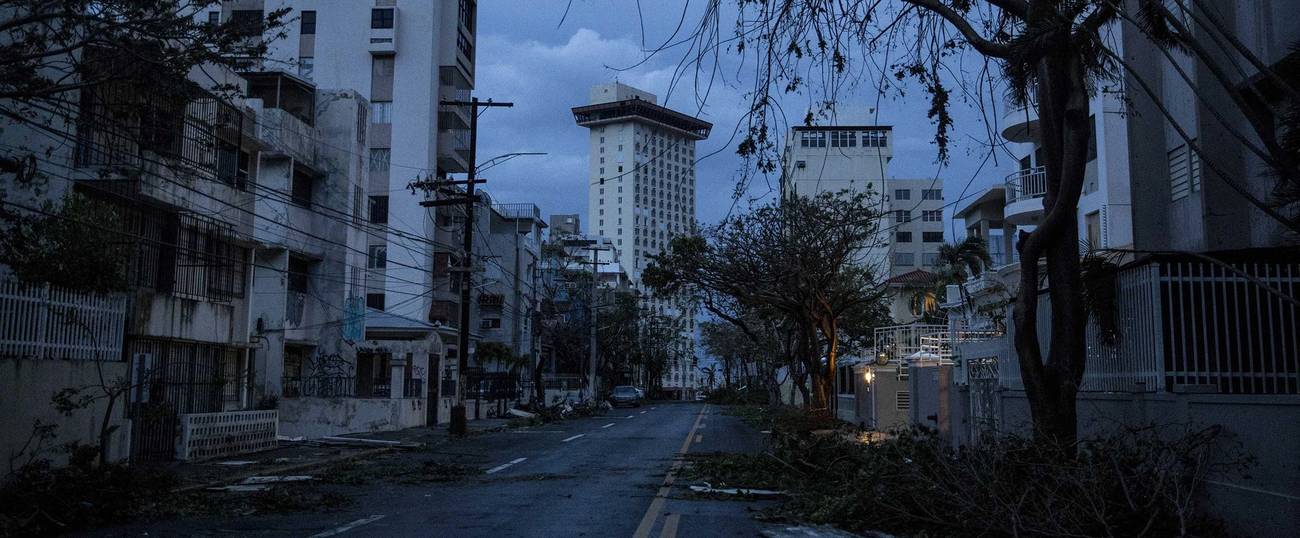Puerto Ricans and Jews, Adrift Together on Their Islands
Why Hurricane Maria is only part of the problem in the U.S. territory




Among other parts of her progressive platform, Alexandria Ocasio-Cortez, winner of the Democratic primary for New York’s 14th congressional district, serving northern Queens and the eastern parts of the Bronx, calls for solidarity with Puerto Rico. The tiny island could sure use the help. Hurricane Maria swept across Puerto Rico in September, leaving a trail of devastation in its wake, including 64 dead, according to the local government’s account, and by other estimates more than 4,000.
In May I visited Puerto Rico with a fact-finding delegation sponsored by the American Jewish Committee’s Latino Jewish Leadership Council. Among other things, I found that electricity was still out in parts of the island. But the most powerful storm to hit Puerto Rico in recent history is only part of the problem.
Puerto Rico is more than $70 billion in debt and under control of a federal oversight board created by the U.S. Congress that has had mixed success urging the government to implement reforms. More than 40 percent of Puerto Rico’s residents live below the poverty line, the middle class is leaving the island in droves, and the business community is unsure of how to get Puerto Rico on its feet.
The other thing I found, in the place of my birth, is that I’m likely Jewish.
It was the first time I’d returned to the island since my grandmother died eight years ago at the age of 106. Like a traditional Puerto Rican widow, she dressed in black every day, and every day she went to mass at the Catholic church around the corner until she could no longer walk. At one time she was in possession of a plant with a frond that appeared to have an image of Jesus praying. Puerto Ricans came from all over the island to visit her home and witness the miracle of the palm.
But she was raised in a home that observed at least some Jewish traditions. It was only after my grandfather died that she spoke of the Friday night dinners where the family lit candles and said prayers in a language that she didn’t understand then and couldn’t recall later. My late mother welcomed the prospect that she and therefore her children were secretly Jewish.
“What’s your grandmother’s last name?” one AJC official, Juan Dircie, asked me while we were touring Old San Juan. “Maduro,” I told him. “Well that settles it,” he said. “That’s the name of one of the big Sephardic families.”
The Jewish community of Puerto Rico numbers around 1,500, most of it centered around the capital San Juan, with three synagogues, a JCC, and a kosher market. In the wake of Maria, the local community distributed food, water, and clothing in conjunction with the Israel-based relief organization IsraAID, whose post-Maria efforts were supported by the AJC.
We visited Loiza, a small town hit hard by the storm and one of the centers of the Afro-Caribbean community. The mayor, an energetic middle-aged woman, was grateful for the help. The AJC had channeled money there through IsraAID, which sent volunteers to the town, like the young woman from California who was distributing Israeli-made water-purification devices.
“Immediately after the hurricane, the AJC activated its institutional resources around the U.S. as well as Israel,” said Dina Siegel Vann, director of the AJC’s Belfer Institute for Latino and Latin American Affairs. Relief aid was only one part of the effort. “The Latino Jewish Leadership Council helped draft legislation for immediate relief,” said Siegel Vann, “and wrote letters to FEMA and DHS. Also, a big part of it was going to Capitol Hill with our Latino partners to advocate for Puerto Rico.”
Siegel Vann, who was born in Mexico City, knows Puerto Rico well. She was heartbroken by the devastation. “I realized how the island was all but abandoned,” she said. “U.S. citizens were left in limbo. But the important thing to keep in mind is that while people are seeing Puerto Ricans as victims they’ve also contributed enormous amounts to the greatness of American society and culture.”
Ignoring the devastation, she said, “is betraying core American and Jewish values, ethically and historically and pragmatically.”
Clearly, there are similarities between the Puerto Rican and Jewish communities. There are nearly seven million Jews living in the United States and roughly six million Puerto Ricans, both concentrating in the same states, New York and Florida. Indeed, Orlando appears to be growing into the largest Puerto Rican community on the mainland—and the destination for many of those who fled in the wake of the storm.
Estimates of how many Puerto Ricans left after Maria vary, with the high somewhere around 200,000. Another survey looked at cellphone data to show that 400,000 left after the storm, but 350,000 have returned.
The more significant concern is that even before the storm hit, more than half a million people, out of 3.8 million, have left the island over the last decade. One study shows that within the next few decades the population will dip to three million.
The Puerto Rican version of the American Dream was to go to the mainland, succeed, and come home and buy a nice house on the beach. But people aren’t coming back. The economy is in shambles. The tax breaks that encouraged U.S. companies, especially those in the pharmaceutical industry, to set up shop on the island without paying federal income tax led to a modest boom in the 1980s and ’90s.
It’s true that Washington has often neglected Puerto Rico, whose inhabitants became U.S. citizens in 1917, almost 20 years after the island became a U.S. possession. However, the federal government has also tried to help Puerto Rico to its feet.
The tax breaks represented efforts to industrialize Puerto Rico, which benefited both the Puerto Rican middle class and big business. And it did push the manufacturing sector forward, which the island’s political and business leaders might have continued to build. At the very least, Puerto Rican leadership should have prepared constituents for the likelihood that at some point Washington was going to want to bill American companies. With a bilingual workforce already trained in manufacturing, what was the next move?
Instead, Puerto Rico has frequently been run like a third-world country, reflected in the fact that the percentage of those living in poverty are at third-world levels. A major employer like the power authority was seen as a source of political patronage and mismanaged for nearly half a century. That, more than federal neglect, is why it’s been so difficult to get the lights on and keep them on.
When the tax incentives were finally phased out in 2006, Puerto Rico fell into a deep recession from which it hasn’t recovered. And the numbers suggest that the prospects for recovery are dim. A 2017 study showed that participation in the labor force is at 40 percent. Roughly one-quarter of the work force is employed by the island’s government, which offered retirement benefits it could not afford.
As we were walking through a suburb of Loiza, I saw a horse beside a clear expanse of beach eating leaves from a tree. This was scenic Puerto Rico, the kind of Caribbean vista that’s supposed to attract tourists. But turning from the beach, just over my shoulder, was the other Puerto Rico—the Puerto Rico neglected not just by the Trump administration but also by other Puerto Ricans.
The hurricane had ripped the tin roofs off the shacks that lined the dirt road strewn with garbage. The local Jewish community distributed nearly a thousand bright blue plastic tarps to cover the tops of the shacks, protecting the residents from more rain and the sun when it eventually returned.
The AJC’s Latino Jewish Leadership Council had certainly shown solidarity with Puerto Rico. But it’s not clear that all Puerto Ricans are as grateful as the impoverished residents of Loiza.
Shortly after the hurricane hit, the island’s largest paper, El Nuevo Dia, published an op-ed blaming Jews for the federal government’s inadequate response to the storm. Congress is controlled by Wall Street, or more specifically “‘the Jew,’ as the vulgar prototype of true power is called,” wrote Wilda Rodriguez, in a column. “The Jew,” wrote Rodriguez, wants to punish Puerto Rico because of the island’s $70 billion debt. “That we could get away without paying would be fatal to Wall Street morale.”
The column appears to have been removed from El Nuevo Dia’s website after a mixed apology from the publication and a bizarre rationalization from the author. The more serious concern for Jewish organizations is here on the mainland, where the character of the political institution that attracts the loyalty of most Jews and Puerto Ricans alike is in a state of flux. The progressive wing of the Democratic party is increasingly hostile to Israel, a fact driven home by Ocasio-Cortez’s recent primary victory.
One night after dinner at the governor’s mansion during which AJC head David Harris and Gov. Ricardo Rossello traded moving speeches about the friendship between Jews and Puerto Ricans, I wondered if it was useful to compare Puerto Rico to Israel. We’d visited various NGOs and spoke with business leaders who touted the island’s resources. Why couldn’t Puerto Rico become a new tech and service center? The work force is American, among which are plenty of college graduates, and even more are bilingual. Why can’t Puerto Rico serve as sort of information hub bridging the mainland and Latin America?
It’s certainly possible. The only problem is that Puerto Ricans themselves don’t buy it. They’re leaving the island.
***
Like this article? Sign up for our Daily Digest to get Tablet Magazine’s new content in your inbox each morning.
Lee Smith is the author of The Permanent Coup: How Enemies Foreign and Domestic Targeted the American President (2020).